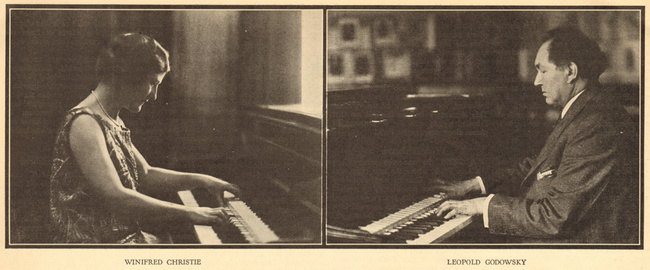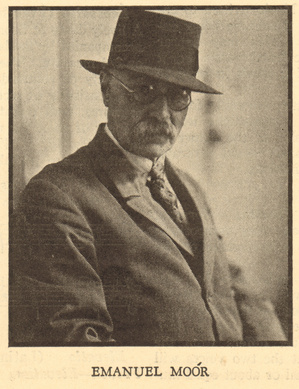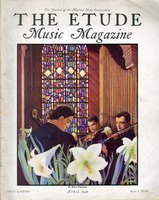Should the Piano Have Two Keyboards?
An Interview with the Distinguished Piano Virtuoso
WINIFRED CHRISTIE
SECURED EXPRESSLY FOR THE ETUDE MUSIC MAGAZINE
By LAURA REMICK Copp
An Interview with the Distinguished Piano Virtuoso
WINIFRED CHRISTIE
SECURED EXPRESSLY FOR THE ETUDE MUSIC MAGAZINE
By LAURA REMICK Copp
 Editor’s Note
Editor’s Note TWO YEARS AGO the Editor of THE ETUDE MUSIC MAGAZINE had the good fortune to be the guest for the day of M. and Mme. Emanuel Moór, at their magically beautiful home at St. Eloi, Mont Pèlerin sur Vevy, Switzerland. The view from the garden of the Moór home is so entrancing that it defies description. Below, nearly a thousand feet, gleams Lake Geneva, and beyond are the snow-clad Alps with the majestic Dent de Midi looming up like giant tusks in the air. The kaleidoscope of colors is unending, from the golden reds of dawn to the deep purples of twilight.
Emanuel Moór is one of the most unusual musicians in the world to-day. He was born in Budapest in 1862 and was educated in Budapest and Vienna. From 1885 to 1887 he was in the United States, directing orchestral concerts at which many famous artists (including Lilli Lehmann) appeared. He then devoted a considerable time to composition, producing works which have been acclaimed when given by the leading symphony orchestras of the world. He has written four operas and seven symphonies. Some one hundred and fifty of his works have been published by leading music houses. Many have been played by world famous artists. He is a man of extreme modesty but strong artistic convictions. Mme. Moór (Winifred Christie) is of English birth. She has toured as a piano virtuoso, with great success, in Europe and America, and has also made a distinct reputation by playing the Moór piano with two keyboards.
M. Moór has not confined his inventive genius to the piano but has at his home a remarkable collection of string instruments of his own design and make, which exhibit extraordinary possibilities.
Improving the Piano
FOR YEARS composers have been striving to add to the piano certain features which might increase its scope. Beethoven is quoted as saying that “The piano is, and will continue to be, an unsatisfactory instrument.” If Beethoven had heard the magnificent instruments produced by the best American piano makers, he would have marveled at their beauty and advance over the instruments he knew. Franz Liszt looked forward to an instrument with two or even three keyboards, as is evidenced by the following quotation from the Revue et Gazette Musicale of 1838.
“The piano is more and more extending its horizon, and developing in new directions. We play harp-like arpeggios, prolonged notes like those of wind instruments, and we try for staccato and other effects formerly considered the province of some special instrument. Progress in piano manufacture will certainly supply those contrasts of tone which are still lacking. The sustaining pedal is an expression of the universally-felt need for expansion. The organ keyboard, with its varied range, will lead naturally to the creation of pianos with two or three keyboards, which will carry all before them in the realm of music.”
 A Prophecy Fulfilled
A Prophecy Fulfilled THIS PROPHECY of Liszt found quite by accident, was the inspiration of this instrument which Emanuel Moór devised in 1921 and which has been made by various manufacturers in different countries. THE ETUDE does not pretend to say what the future of the two-keyboard piano may be. That must be determined by the musicians themselves. While simplifying playing in some respects, it must also open up an entirely new field for the teacher, as it makes additions to the technical methods of interpretation at the keyboard. The project has commanded the investigation of the dignified “Grove’s Dictionary of Music and Musicians”; and in it Professor Donald Tovey describes the instrument thus:
New Possibilities
“THE REAL IMPORTANCE of the invention lies in its entirely new resources. The principle is simple and might just as well have been discovered when the pianoforte was first invented: in which case Mozart’s pianoforte technic would have begun considerably beyond the point where Beethoven’s now leaves off.
“THE REAL IMPORTANCE of the invention lies in its entirely new resources. The principle is simple and might just as well have been discovered when the pianoforte was first invented: in which case Mozart’s pianoforte technic would have begun considerably beyond the point where Beethoven’s now leaves off.
“Two manuals are placed, the one so slightly raised above the other that a perfect legato in rapid passages is obtainable between them by one hand. The second manual is an octave higher than the first. Thus the normal stretch of one hand is two octaves instead of one; and, with the cultivation of movements of the hand backwards and forwards as well as laterally, the possibilities of pianoforte-writing already seem limited only by pure musical aesthetics. But this is not all; the two manuals can be coupled together by a pedal, so that the instrument possesses much of the property of the organ, and also that of the harpsichord, in the power of doubling a whole mass of harmony, or any part thereof, in four-foot tone.
“There is a vast new technic awaiting study and exploration; but the merest rudiments of it produce astonishing results in a short time, for the pianist who gave the first public demonstration did so within six days of setting eyes on the instrument.
“The double-keyboard pianoforte sets a premium upon a Bach-like and Mozart-like cultivation of polyphonic cantabile. Many composers use the pianoforte in the act of composition far more than they are willing to admit. They know it to be a bad habit, because it tends to cramp their invention in two directions : it confines phrasing to the obvious sequences that muscular memory best grasps, and it confines part-writing to the compass and convenience of the hands. The second limitation is now removed, and those composers who suffer from the ‘pianistic’ habit may learn from it a greater freedom in their writing for other instruments and for orchestra.”
The Idea Grows
THE POPULARITY of the harpsichord in its day and its present slight revival indicate that the public has an open mind to a two-keyboard instrument, if it is convinced that such an instrument will serve the higher purposes of art. The introduction of any change in an instrument often demands decades; and the innovator only rarely has the good fortune of Emanuel Moór in seeing his instrument introduced and employed by outstanding pianists. Godowsky and many others have played the Moór piano and have been deeply impressed with its possibilities. Busoni foresaw the scope of a two-keyboard instrument. In 1905 he wrote:
THE POPULARITY of the harpsichord in its day and its present slight revival indicate that the public has an open mind to a two-keyboard instrument, if it is convinced that such an instrument will serve the higher purposes of art. The introduction of any change in an instrument often demands decades; and the innovator only rarely has the good fortune of Emanuel Moór in seeing his instrument introduced and employed by outstanding pianists. Godowsky and many others have played the Moór piano and have been deeply impressed with its possibilities. Busoni foresaw the scope of a two-keyboard instrument. In 1905 he wrote:
“I discussed with a well-known piano maker a project for a new piano. The idea is to install two manuals (keyboards), the register of the clavicembalo and the coupling (doubling of octaves) into the so-called ‘modern’ piano. If that could be accomplished it would mean the advent of a new epoch in piano playing.”
Your editor, in playing upon this instrument, found that its action was very similar to that of the ordinary pianoforte. He estimated that, while many of its advantages might become immediately available to one trained in the orthodox piano technic of the past, it would take a considerable length of time to become orientated to the possibilities of the two keyboards as a means of expression in pianistic art. At the same time the potentialities of such an instrument offer endless fields for exploration for effects.
An Uncertain Future
THE PROGRAMS played by Madame Moór displayed great variety of tonal effects and a surprising virility. It is impossible for any critic to foresee what will be the future of this instrument, as that will depend entirely upon the reception that it receives through the years from the musical public.
THE PROGRAMS played by Madame Moór displayed great variety of tonal effects and a surprising virility. It is impossible for any critic to foresee what will be the future of this instrument, as that will depend entirely upon the reception that it receives through the years from the musical public.
In appearance the piano is quite like an ordinary grand piano, save for the two keyboards, one above and back of the other. These keyboards have the merit of being like those of the now standard makes and are not radically different from those of another notable Hungarian inventor, Janko, whose keyboard, once the curious sensation of the musical world, is now practically forgotten.
Mme. Moór’s interview, as transcribed by Miss Laura Remick Copp, follows:
A New Instrument is Born
“Emanuel Moór’s interest in the two-piano keyboard is characteristic of the aspiring attitude which has marked his life. He has continually sought not only more beautiful and more simple means of expression but also more rational methods.
“Emanuel Moór’s interest in the two-piano keyboard is characteristic of the aspiring attitude which has marked his life. He has continually sought not only more beautiful and more simple means of expression but also more rational methods.
“He experimented on an old instrument in his own home. He made a model in his own workshop in Switzerland. demonstrating his ideas, which are to keep all of the good qualities and acquisitions of the piano of today and to add to them effects possessed by the clavecin but lost when the hammer piano came in. As M. Moór himself says, ‘It seems hardly comprehensible why the piano, when it replaced the clavecin, gave up the rich effects of two keyboards and a coupling. In this respect the hammer-piano brought no improvement. In fact, it was rather a step backward, for the technic of the virtuoso. This elementary fact so inspired me that I busied myself with the development of pianos along constructive lines.’
With Orchestra
“AFTER the numerous presentations in Paris, where the new piano was heard with the Colonne and Pasdeloup orchestras, it was unanimously recognized that in comparison with it a single-manual piano sounded colorless and afforded little opportunity for expression of the musical thoughts of the masters, particularly those of the greatest creative musician of all times—Johann Sebastian Bach.
“AFTER the numerous presentations in Paris, where the new piano was heard with the Colonne and Pasdeloup orchestras, it was unanimously recognized that in comparison with it a single-manual piano sounded colorless and afforded little opportunity for expression of the musical thoughts of the masters, particularly those of the greatest creative musician of all times—Johann Sebastian Bach.
“Bach’s biographer, Wolf rum the Heidelberger, mentioned that Bach never composed for the hammer piano, as this instrument lacked the tone-color of his clavicembalo with its two manuals, coupler and register-stops. Bach never used the modern octave technic. His octaves were couplings, as on the organ, which in forte as well as piano, gave the performance an entirely different character from the laborious octave hammering.
Enriched Technical Resources
“LIKE the organ, on the cembalo all repetitions and sequences, which offer such pleasant variety on the different manuals, are easily executed, while on the piano, as we know it today, these changes in tone-color and expression cannot be produced without comparatively great effort. It can he assumed as common knowledge that Bach himself transcribed his own violin and piano compositions for the organ, the lute or orchestra.”
“LIKE the organ, on the cembalo all repetitions and sequences, which offer such pleasant variety on the different manuals, are easily executed, while on the piano, as we know it today, these changes in tone-color and expression cannot be produced without comparatively great effort. It can he assumed as common knowledge that Bach himself transcribed his own violin and piano compositions for the organ, the lute or orchestra.”
Choice of Fingers
THEN, as Miss Christie says, “One can always use his best fingers on this instrument instead of his worst.” She proceeded to prove this by playing a passage from Schumann’s Carnaval. Traumeswirren, another composition by Schumann, is a good example for the use of good fingers in both hands instead of poor ones; and this is a very tricky piece! In crossing hands, where ordinarily one must get his body into awkward and uncomfortable positions—detrimental oftentimes to the musical sound of the passage—this can be eliminated by playing the part for one hand on the upper keyboard. A good example is the D-fiat concert study of Liszt, in which the hands cross continually for the high notes, which incidentally are the melody.
THEN, as Miss Christie says, “One can always use his best fingers on this instrument instead of his worst.” She proceeded to prove this by playing a passage from Schumann’s Carnaval. Traumeswirren, another composition by Schumann, is a good example for the use of good fingers in both hands instead of poor ones; and this is a very tricky piece! In crossing hands, where ordinarily one must get his body into awkward and uncomfortable positions—detrimental oftentimes to the musical sound of the passage—this can be eliminated by playing the part for one hand on the upper keyboard. A good example is the D-fiat concert study of Liszt, in which the hands cross continually for the high notes, which incidentally are the melody.
“The upper keyboard is an octave higher in pitch than is the lower, and one reaches very easily from one to the other, often playing on both at the same time with the same hand. This double keyboard obviates large stretches and makes it possible to play tenths and large intervals with perfect ease and smoothness. It entirely does away with big broken jumps.
Amplified Resources
“ HE COUPLING EFFECT taken from the old clavecin is operated and made possible by a pedal, the middle one of the three, which affects the lower keyboard only; and such a passage as that in octaves in Beethoven’s Waldstein Sonata can now be played legato, as the composer really intended it. No one could make this octave passage legato on the usual piano; but now it is easy and sounds as the composer wished it. Bass notes can now be held where this was formerly impossible, as in another Fantasy-piece by Schumann, Des Abends (At Evening). Phrasing is greatly aided as is also clarity; and the remarkable effects of more resources as to overtones are quite overwhelming.
“ HE COUPLING EFFECT taken from the old clavecin is operated and made possible by a pedal, the middle one of the three, which affects the lower keyboard only; and such a passage as that in octaves in Beethoven’s Waldstein Sonata can now be played legato, as the composer really intended it. No one could make this octave passage legato on the usual piano; but now it is easy and sounds as the composer wished it. Bass notes can now be held where this was formerly impossible, as in another Fantasy-piece by Schumann, Des Abends (At Evening). Phrasing is greatly aided as is also clarity; and the remarkable effects of more resources as to overtones are quite overwhelming.
“These new possibilities are an aid to modern music as well as old. In Debussy’s Les Tièrces Alternées (Alternated Thirds), where the hands continually interlock, those thirds fairly scintillate when the part for one hand is taken on the upper keyboard, thus gaining perfect freedom. In Jeu d’eau and Ondine by Ravel there are passages where the hands are continually on top of each other.
The Voice of the Harpsichord
“IN HARPSICHORD MUSIC more color can be given to these old compositions, as in the Italian Concerto, for example, where it is necessary to differentiate between the solo and tutti passages; but the greatest triumph really is that it is now possible to play Bach Fugues with the same clearness as on the clavicembalo or organ, emphasizing certain tones, building contrasts and dynamics similar to those on an organ, and at the same time preserving the typical peculiarities of the piano.
“This invention makes the piano a polyphonic instrument and brings back to it the wealth of color which its predecessors possessed and which has been abandoned with the construction of the modern piano. This is an invention by a musician: for M. Moór is an organist and a pianist. He was also a pupil of Liszt. Casals plays many of his compositions, as do Ysaÿe, Thibaud and many other artists.
“The two-keyboard piano is the most significant innovation made in piano mechanism in one hundred and fifty years. In Germany it has been acclaimed unanimously by critics and public, when it has been demonstrated and played in special recitals in all of the principal cities.



